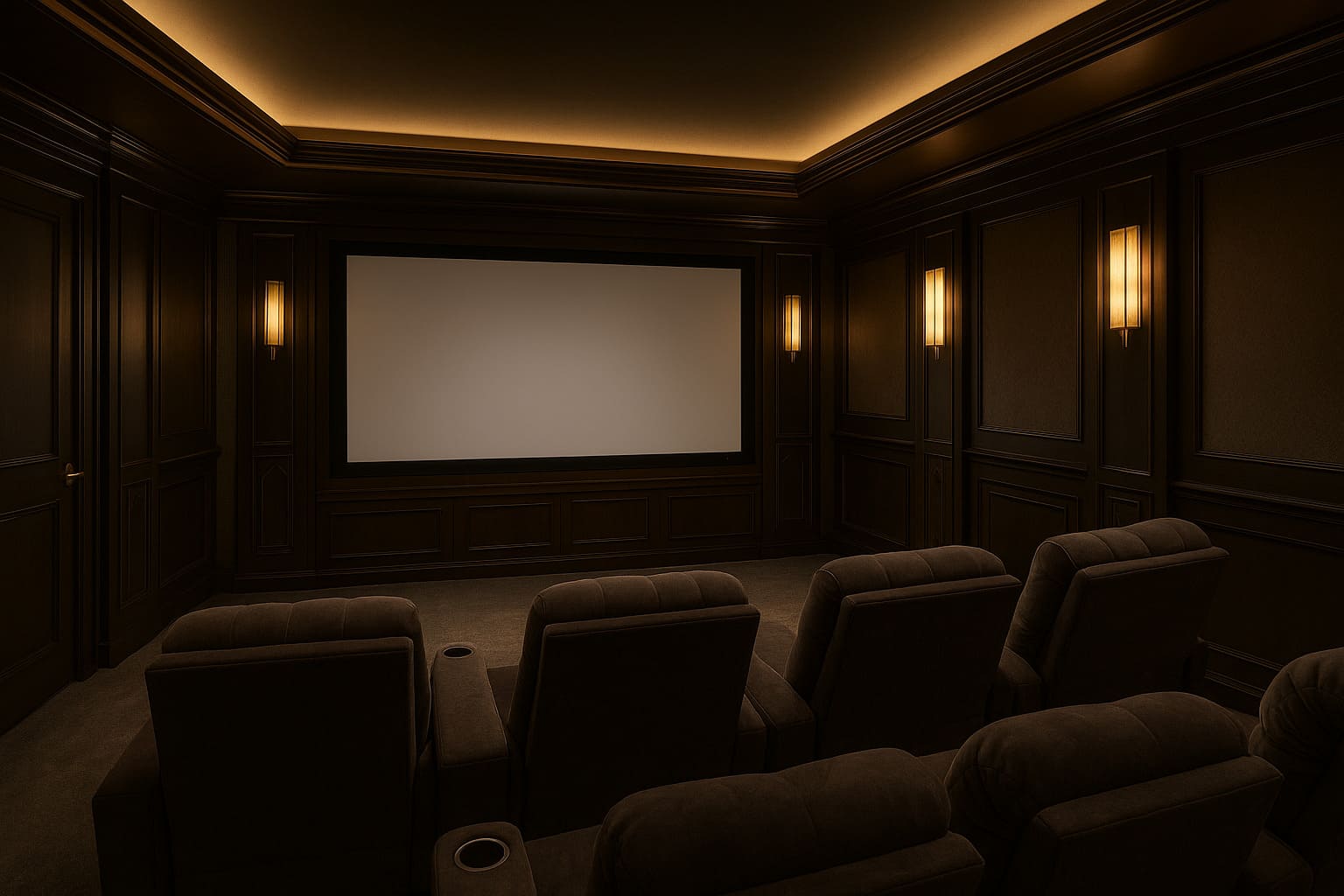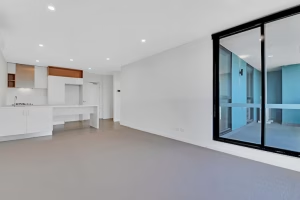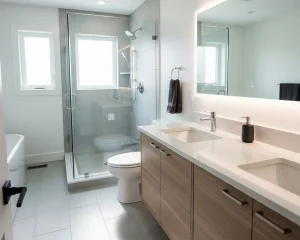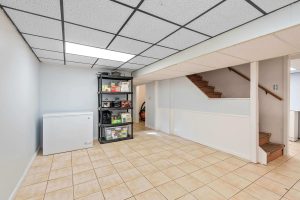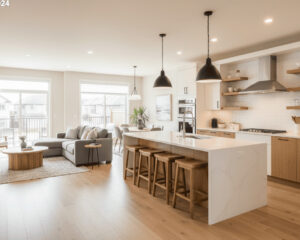Basements are ideal for home theatres. They’re isolated from street noise, often have controllable lighting, and offer flexibility for speaker placement. Still, basements bring unique challenges: moisture control, lower ceiling heights, mechanical noise, and egress or code implications if the space becomes a multi-use area or a legal suite. This article gives you a clear roadmap, from the first site review to the night you press play, with local references and practical steps tailored for Edmonton homes.
Before you start swinging hammers, know that many permit requirements and inspection points apply when you alter mechanical, electrical, or structural systems. The City of Edmonton’s renovation guidance and permit pages are the right place to confirm what you need.
Start with a site review and a clear brief.
A quick, practical feasibility review saves headaches later. For a basement home theatre, a site review checks:
- Ceiling height and beam locations.
- Location of mechanical equipment and duct runs.
- Moisture indicators: previous dampness, sump pumps, window wells.
- Electrical panel capacity and potential dedicated circuits.
- Egress paths and how the room links to the rest of the home.
Turn that into a one-page brief that lists priorities: level of sound isolation, seating capacity, whether the room will double as a family room, and how visible AV equipment should be. This brief keeps designers and contractors aligned. Steadfast Constructions Ltd. provides focused site reviews in Edmonton that flag likely permit triggers and mechanical constraints early.
Planning the layout and sight lines
Good sight lines and seating geometry are the backbone of any home theatre. Follow these principles:
Screen placement and seating geometry
- Place the screen on a solid wall opposite the main seating area.
- Arrange seats so the primary viewing angle is within the recommended sweet spot for your projector or TV. Standard practice keeps the eyes at roughly one-third up the screen height.
- Allow circulation behind and between seating rows if you want multiple rows or a hospitality zone.
Multi-use considerations
If the room will double as a family room or play area, plan modular seating and concealed AV cabinetry so the space transitions without visible clutter.
Acoustics and sound control
Sound is the hard part. Good acoustics turn good gear into great experiences.
Isolation vs treatment
There are two related goals: to stop sound from leaving the room and to control sound inside the room.
- Isolation reduces noise transfer to the rest of the house and neighbours by using mass, decoupling, and sealing. Common techniques include double-stud walls, resilient channels, and acoustic sealants on all penetrations.
- Treatment addresses the room’s internal sound: bass traps, absorptive panels at first-reflection points, and diffusion to prevent dead spots. A mix of absorption and diffusion usually gives the most balanced sound.
An acoustician or an experienced AV contractor can model the room and recommend targeted improvements. If your neighbours are close or your upstairs rooms are used during evening hours, isolation deserves priority.
Speaker placement and bass control
- Dedicated subwoofer placement tests are essential. Basements often emphasize low frequencies; standing waves are common. Move subs and test positions rather than relying only on measurements.
- In-wall or on-wall speakers save space but ensure cavity treatments and proper mounting to avoid rattles.
- Reserve at least one wall cavity for acoustic insulation and avoid leaving large empty runs behind speakers.
Lighting and sight-line control
Lighting makes or breaks the cinema mood.
Layered lighting
Use layers of lighting to switch moods easily:
- Low-level aisle or step lights for safe movement.
- Dimmable general lighting for cleaning and casual use.
- Accent lighting for architectural elements or shelving.
- Task lighting in concession or bar areas.
Recessed cans should be placed carefully to avoid reflections on glossy screens. For projectors, black-backed screens and controlled ambient light are essential for picture quality.
Window and daylight control
If your basement has egress windows or daylighting, use blackout shades or shutters. Proper daylight control maintains contrast and keeps the room usable both day and night. Combine window treatments with ambient light baffles to avoid screen glare.
HVAC, ventilation, and mechanical noise
Basements contain mechanical systems and ducts that can add hum and rattle.
Quiet HVAC solutions
- Isolate ductwork runs and vibration points with flexible connectors.
- Use oversized but low-speed fans to move air quietly; then zone controls maintain comfort without high fan speeds.
- Keep mechanical equipment (furnace, water heater) separated by a service corridor or properly insulated closet if possible.
When ducts run through the theatre space, plan acoustic lining in ductwork and consider separate ventilation paths for the theatre to reduce noise and pressure differentials. Any mechanical changes should be coordinated with your contractor and noted on permit drawings. The Alberta implementation of the National Building Code affects the mechanical and ventilation requirements you must follow. nrc.canada.ca
Wiring, power, and AV infrastructure
A good basement home theatre needs thoughtful infrastructure beneath the finishes.
Power planning
- Put AV gear on dedicated circuits to avoid noise and tripping breakers.
- Plan accessible power behind equipment racks and under seating for powered recliners.
- Include surge protection and high-quality grounding; consult a licensed electrician.
Data, control, and speaker runs
- Run balanced audio lines and use conduit for future upgrades.
- Pre-wire for multiple speaker positions and hardwire network drops for streaming sources.
- Consider structured wiring for a central hub. Label every run and leave access panels for future servicing.
Licensed electrical work and any changes to breaker capacity, demand permits, and inspections in Edmonton, so coordinate these early with your contractor. edmonton.ca
Screen, projector, and TV choices
Pick the visual system to match your room size and ambient light.
Projector vs TV short guide
- Projectors suit large screens and darker rooms and deliver a cinema feel. They require careful placement and controlled light.
- Large, high-contrast TVs are simpler and deliver high brightness in rooms with less light control.
- Consider screen gain, viewing distance, and seating tiers when choosing.
Projector installations need enough throw distance or a short-throw lens. Integrate the projector mount into the ceiling structure and plan for service access.
Seating, sightlines, and comfort
Comfort keeps people in their seats.
Seating options
- Choose tiered seating for multiple rows or staggered seats for better sight lines.
- Recliners with built-in power options need below-seat power planning.
- Keep adequate walkway and egress routes compliant with local safety expectations.
Acoustic carpeting and upholstered finishes help absorb high frequencies and reduce reflections, improving both sound and comfort.
Finishes, aesthetics, and themed rooms
Aesthetic choices affect acoustics and maintenance.
Materials that work
- Use non-reflective paints near the screen and acoustically transparent fabrics where speakers sit behind screens.
- Avoid large expanses of glass or glossy tile that create reflections unless carefully controlled.
- For a retro or art-deco home theatre, use heavy curtains and period finishes but keep modern acoustic treatments behind them.
Moisture control and long-term durability
Basements demand attention to moisture.
Waterproofing checklist
- Confirm the basement is dry before finishing. Look for signs of prior dampness and address exterior grading, window wells, and sump systems if needed.
- Use moisture-tolerant wall and floor assemblies in the theatre. Avoid materials that trap moisture or delaminate in humid conditions.
- Include a dehumidification plan in climates like Edmonton, where indoor humidity can spike seasonally.
Addressing moisture early preserves finishes, electronics, and the sound environment.
Permits, codes, and safety in Edmonton
Major electrical, structural, or mechanical changes generally require permits. Edmonton’s residential renovation guides explain what the city expects for modifications. If your basement theatre involves new wiring, additional circuits, moving HVAC runs, or structural openings, plan permit submissions and staged inspections. Early coordination avoids delays and ensures work passes inspection cleanly. edmonton.ca
Recent national and provincial building code updates affect mechanical and energy requirements for renovations in Alberta. Working with a contractor who keeps designs aligned with the National Building Code – 2023 Alberta Edition avoids rework and ensures compliance. nrc.canada.ca
Project workflow and coordination
A successful basement home theatre project follows a clear sequence.
- Feasibility review and brief.
- Layout, schematic acoustic plan, and AV infrastructure plan.
- Permit-ready drawings if systems are being altered.
- Rough-in of electrical, HVAC, and speaker runs. Inspections were required.
- Isolation and acoustic works, then drywall and finishes.
- AV installation and calibration.
- Commissioning, user training, and project handover with documentation.
Steadfast Constructions Ltd. coordinates trades and inspections in Edmonton so homeowners avoid becoming the middle person between city reviewers and technicians.
Real-world Edmonton example
A midtown Edmonton family wanted a flexible basement home theatre that doubled as a game room. Our design team prioritized sound isolation to protect upstairs bedrooms and created a stepped seating area for two rows. The contractor coordinated a separate ventilation duct with acoustic lining and installed a dedicated electrical subpanel for AV gear. Acoustic panels were integrated into the décor, and a projector with a motorized screen was hidden behind decorative millwork. The project file included permit sign-offs and a maintenance guide that the homeowners could keep for future buyers. That level of documentation simplified a later appraisal process and made the space genuinely usable for both movies and kids’ activities.
Why documentation and warranties matter
A good contractor hands over a project folder that includes permit approvals, inspection sign-offs, electrical diagrams, AV wiring labels, and warranty paperwork. Keep that folder. It protects you during maintenance, insurance claims, and resale. Steadfast delivers a detailed closeout package for each basement renovation so homeowners have a single source of truth at handover.
Recent data from Statistics Canada shows renovation activity remains active nationally, indicating steady demand for quality contractor services and the importance of professional documentation on renovated spaces. www150.statcan.gc.ca
Practical checklist before you start
- Book a short site review with a contractor or designer.
- Photograph and measure the room; note mechanical equipment and egress.
- Decide whether the room is single-purpose or multi-use.
- Sketch seating and screen positions to check sightlines.
- Identify electrical and ventilation needs early and plan for permits.
- Plan for acoustic isolation and moisture control.
- Ask for a project folder and written warranties at handover.
Expert quote
“A basement home theatre is a systems project, not a decor project. Get the acoustics and mechanicals right first and everything else falls into place,” says Daniel Hart, Lead AV Consultant at a local integrator in Edmonton. “A modest investment in isolation and proper wiring pays dividends in long-term enjoyment.”
Conclusion
Designing a basement home theatre is an exercise in trade coordination and smart choices: sound isolation, mechanical quieting, proper wiring, and light control all matter more than a single massive purchase. Start with a feasibility review, align the design with local permit requirements, and work with trades who document every step. If you want help turning a basement into a screened, comfortable entertainment room in Edmonton, Steadfast Constructions Ltd. offers site reviews, permit coordination, and full renovation management. Contact Steadfast Constructions Ltd. to arrange a no-pressure feasibility visit and get a clear plan that protects your home and delivers the cinema experience you want.
Frequently Asked Questions (FAQs)
Q1: What are the main steps to create a basement home theatre?
A1: Start with a site review, define seating and screen placement, plan acoustic isolation and HVAC, run dedicated electrical and AV wiring, finish surfaces, install AV equipment, and complete testing and tuning. Coordinate permits if you alter electrical, mechanical, or structural systems.
Q2: Do I need permits to install electrical and HVAC for a basement home theatre in Edmonton?
A2: Yes. Changes to electrical panels, new circuits, or mechanical/ventilation alterations typically require permits and inspections through the City of Edmonton. Confirm requirements early with your contractor.
Q3: How can I reduce sound transfer from a basement home theatre to upstairs rooms?
A3: Use mass and decoupling: double-stud or staggered-stud walls, resilient channels for ceilings, acoustic sealants on penetrations, and insulating cavities. Combined with interior acoustic treatment, these measures improve both isolation and in-room sound quality.
Q4: What HVAC considerations matter for a basement theatre?
A4: Plan low-noise supply and return paths, use vibration isolation on equipment, and consider a dedicated ventilation path if possible. Quiet airflow and properly sized ducts make a huge difference for cinema-level listening.
Q5: How do I future-proof wiring when building an AV room?
A5: Run extra conduits and labeled empty sleeves, pull multicore speaker runs, include network drops near equipment racks, and leave service access panels. Document every run and label both ends for future upgrades or changes.

